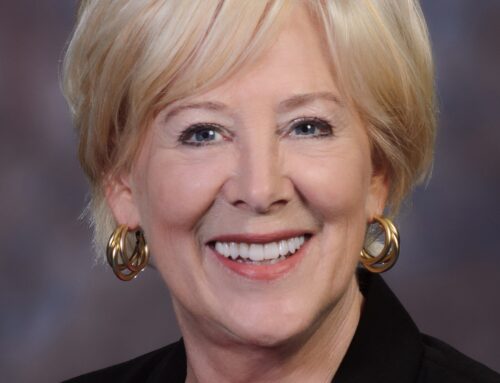 These are challenging times for the school staff and parents who are working with schools to ensure the next generation of students will graduate to be skilled, career- and college-ready citizens. The COVID-19 pandemic forced schools across the country to close and impacted the learning of students. The 2022 NAEP results and graduation rates show the impacts of the disruption in learning. Throughout it all, our highest-need students have been hit the hardest. We have evidence-based, effective solutions that can be implemented to begin reversing the negative trends and gaps that the pandemic exacerbated. One strategy to improve student outcomes is to prepare students for emerging new-collar jobs.
These are challenging times for the school staff and parents who are working with schools to ensure the next generation of students will graduate to be skilled, career- and college-ready citizens. The COVID-19 pandemic forced schools across the country to close and impacted the learning of students. The 2022 NAEP results and graduation rates show the impacts of the disruption in learning. Throughout it all, our highest-need students have been hit the hardest. We have evidence-based, effective solutions that can be implemented to begin reversing the negative trends and gaps that the pandemic exacerbated. One strategy to improve student outcomes is to prepare students for emerging new-collar jobs.
The prevalence of new-collar jobs has grown. While they do require a college education for some, new-collar jobs are mostly “middle-skill” jobs that require a high school diploma, a foundation in math and science, and some additional skills and training acquired through apprenticeships and/or credentialing programs.
According to the Bureau of Labor Statistics (BLS), the economy will create millions of new-collar careers and only 27.1 percent will require a college degree. The job market is evolving. Yet, 63% of high school graduates still enroll in college, and 53% of recent college graduates are unemployed or underemployed. These students spend four years or more sacrificing, working hard, and taking out loans for their bachelor’s degree only to end up in a job that requires a high school diploma. During the Covid-19 pandemic, undergraduate enrollment at four-year institutions declined by nearly 8%. High-school graduates are flocking to shorter, less expensive “pathway programs” that often have higher completion and job placement rates thanks to their alignment with employers’ needs. Rising student demand for vocational training programs, particularly in the post-pandemic economy, can help narrow the labor gap in essential jobs.
What needs to be reevaluated?
According to the EconoTimes, two out of five employers believe school and college graduates are unprepared for employment. One-third of employers are dissatisfied with the young people’s relevant work experience. Only 5% of individuals in the United States believe high school graduates are well equipped for employment, and only 13% believe college graduates are well prepared.
Most public school curriculums are designed with the assumption that all students aspire to go to college. While the curriculum is evolving, we need to help more high schools improve the link between high school and work.
A recent study by Opportunity@Work found there are 32 million Americans who lack college degrees but have a foundation of skills that, coupled with proper training, could qualify them for higher-income jobs. The U.S. Bureau of Labor Statistics predicts that many new-collar occupations will see significant growth, measured by the number of new job openings, through 2030. Skilled and credentialed professions are paying off. Twenty-seven percent of people with post-secondary licenses or certificates earn more than the average bachelor’s degree recipient. Eighty percent of associate degree holders earn more than the bachelor’s median income.
Employers, parents, and educators need to stop referring to these new-collar jobs as “trades and vocations”. We should learn from Germany and Switzerland where new-collar jobs benchmark workforce development and apprentice programs pay high wages.
Today’s manufacturers need new-collar workers who have more technical and advanced skills than traditional white-collar and blue-collar workers. Manufacturers especially need employees with new-collar skills in sectors like automation, analytics, robotics, and the internet. As job requirements continue to change, manufacturers must develop recruiting and training strategies such as reskilling and upskilling to keep pace with this industry shift.
Pathway Forward
To remedy this situation more parents, employers, and communities need to partner with public schools to make K-12 education more effective. More organizations are now collaborating with local schools by offering programs that prepare students to enter the workforce and/or have a secondary education that includes credentialing, apprenticeships, and, if needed, a college degree. Some of the leading learning organizations doing an outstanding job of closing the growing skills gap for the new-collar workforce are SkillsUSA, CISCO Network Academy, Haas Technical Education Community, FAME program, Tooling U SME, and AME Alliance Partners.
To better understand how successful public-private educational partnerships can work collaboratively with employers, the Association for Manufacturing Excellence (AME) invited New Horizons Regional Education Centers and Newport News Shipbuilding Appreciate School to be on a panel with other leading learning organizations. They presented their best practices on “Learning That Works” at the AME Dallas 2022 international conference.
This partnership focused on the 70 percent of students who, with the right education, can qualify for in-demand jobs that do not require a 4-year degree.. The panel discussed how private partners have collaborated with public schools and employers to transition students from high school into credentialing and apprenticeship programs, and other rewarding opportunities.
Virginia is creating a new type of school that involves unique partnerships called lab schools. These partnerships are between public and private universities and colleges, private companies, and local K-12 schools. Lab schools have a specific focus (i.e., STEM or literacy), skill, or industry that they will create learning environments to engage students in hands-on learning around. Below see a roadmap for 21st century-career-ready citizens to leverage the lab school’s approach for a cradle-to-career roadmap.

Beginning early in a child’s education, these new lab schools can produce amazing results by creating a strong K-12 education focused on reading, math, and science. Students are encouraged to enroll in applied science, technology, engineering, and math (STEM) classes that will prepare them for new-collar jobs at an early age.
Now more than ever, students need an education focused on employable skills and effective learning. Parents and employers need and want students to graduate with a strong work ethic and critical thinkers who can collaborate, and achieve their own “American dream” regardless of their socio-economic background.
Benchmarking Best Practices | Association for Manufacturing Excellence (AME) | www.ame.org
Glenn Marshall of Williamsburg serves on the Association for Manufacturing Excellence (AME) Management Team leadings best practice sharing through benchmarking. Email him at marsh8279@aol.com.




